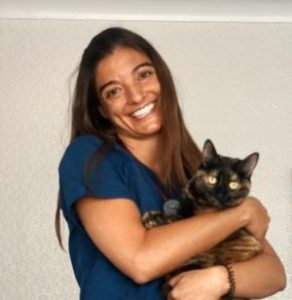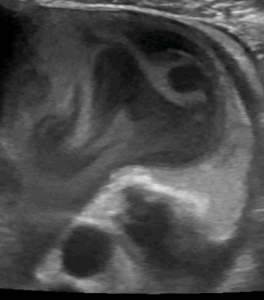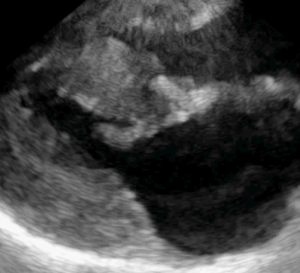New study reveals that almost half of UK pet cats may develop HCM in their lifetimes!
VPS’ Rita Pires reviews the slightly shocking recent literature

Thanks to the RVC cardiology team, we now know a bit more about the natural history of hypertrophic cardiomyopathy (HCM) in a non-referral cat population.
The picture of subclinical HCM presented in earlier publications tends to be biased as the studies were generally based on samples of cats from referral centres examined because of suspicion of heart disease. For example one of the biggest, The REVEAL Study, published a few years back, involved a population sample of 1730 cats from worldwide referral centres.
Fox PR, Keene BW, Lamb K, et al.
International collaborative study to assess cardiovascular risk and evaluate long-term health in cats with preclinical hypertrophic cardiomyopathy and healthy cats: the REVEAL study. J Vet Intern Med. 2018;32(3):930-943.
https://pubmed.ncbi.nlm.nih.gov/29660848/
This study revealed an overall incidence of cardiovascular events and death of approximately 30% in cats with pre-clinical HCM/HOCM.

Spontaneous echocontrast in the left atrium of a cat with HCM phenotype
The initial RVC CatScan I study looked into the natural history and prognosis of HCM in cats from the general population rather than those referred for suspected heart disease. Cats were recruited non-selectively from a population at two rehoming centres.
The Cat Scan study I:
Cardiomyopathy prevalence in 780 apparently healthy cats in rehoming centres (the CatScan study).
Payne JR, Brodbelt DC, Luis Fuentes V.
J Vet Cardiol. 2015;17:S244-S257.
https://pubmed.ncbi.nlm.nih.gov/26776583/
Cats with left ventricular wall thickening were screened for systemic hypertension and hyperthyroidism (if >8 years old).
- The prevalence of HCM phenotype in an adult cat population was 14.7%, congenital disease 0.5% and other cardiomyopathies 0.1%
- The prevalence of HCM phenotype increased with age.
- The positive predictive value of a heart murmur for indicating HCM phenotype was 17.9-42.6% (higher in old cats), and the negative predictive value was 90.2-100% (higher in young cats).
From this study, 107 cats were monitored for a median of 5.6 years (1.2-9.2 years) and the outcomes of this follow up constitute Cat Scan II which was published late 2022.
Natural history of hypertrophic cardiomyopathy in cats from rehoming centres: The CatScan II study
Matos JN, Payen JR, Seo J, Luis Fuentes V
J Vet Intern Med. 2022 Nov;36(6):1900-1912
https://pubmed.ncbi.nlm.nih.gov/36315028/
The main findings were:
- 23% of previously unaffected cats developed HCM phenotype during the study (there was an overall increase in HCM prevalence from 19.6% to 37.4% at follow-up)
- predictors of greater risk of HCM phenotype at follow-up included lower LA fractional shortening %, higher LV fractional shortening% and higher bodyweight
- 21% of cats with HCM had cardiovascular events (ATE, CHF or SD);
- LV wall thickening increased over time in most cats
- the proportion of cats with HCM without SAM (non-obstructive HCM) was higher than in most previous reports of subclinical HCM. “
Similar to the CatScan I, this study also found that the prevalence of HCM phenotype increased with age. Cats with HCM phenotype might include individuals with conditions such as acromegaly or transient myocardial thickening (putative myocarditis or Takotsubo cardiomyopathy): however, it’s probably fair to assume that the vast majority do have ‘primary HCM’.
It’s important to say that the outcomes here are very much dependent on how one defines ‘HCM’. There is a continuum of LV wall thickness. Almost as many cats (18/107) were equivocal/borderline as actually satisfied criteria for HCM phenotype (21/107).

Right long axis 4 chamber view of a cat with severe concentric left ventricular wall thickening and left atrial dilation
In contrast to the referral population in REVEAL, the proportion of cats with HCM without dynamic left ventricular outflow tract obstruction (DLVOTO) caused by systolic anterior motion of the septal mitral valve leaflet (SAM) was higher in these re-homing centre cats. This implies that there are plenty of cats out there with preclinical HCM and without the striking murmurs associated with hypertrophic obstructive cardiomyopathy (HOCM).
More studies are still required regarding the echocardiographic variables that can predict which cats will develop left ventricular wall thickening. However, the LA fractional shortening and the length of the anterior mitral valve leaflet (AMVL) seem promising.
CatScan II findings suggest that, as in human medicine, LA dysfunction might be a marker for early HCM.
Cats with LA FS > 25% are less likely to develop HCM. However, this is only if we use a cut-off for diagnosis of HCM in cats of LVWT >6.0mm. The LA FS is irrelevant if we choose a cut-off at 5.5mm.
“...We repeated the Cox regression analysis using a 5.5 mm cut-off to diagnose HCM, and none of the baseline variables was associated with a higher hazard of HCM, although LAFS% was also lower at baseline in cats that later developed HCM albeit not significantly (P = .05).”
Another study supports that elongated anterior mitral valve leaflets (AMVL) are associated with SAM and could be an early morphological marker of HCM.
Seo J, Novo Matos J, Payne JR, et al.
Anterior mitral valve leaflet length in cats with hypertrophic cardiomyopathy.
J Vet Cardiol. 2021; 37:62-70.
https://pubmed.ncbi.nlm.nih.gov/34610570/
“…The AMVL length was greater in cats that subsequently developed left ventricular hypertrophy. Further studies investigating the clinical application of AMVL in the natural history of feline HCM are warranted.”
Overall, in an adult healthy cat population, the incidence of subclinical HCM is 14.7%. And this increases with age.
Also, the value of a heart murmur to predict HCM increases with age. However, a non-referral population might have a higher incidence of non-obstructive HCM.
The risk of cardiovascular ‘events’ was similar to other studies. And both referral and non-referral centres reported a risk of around 30%.
Take home message: for an average, outwardly-healthy cat in the UK, these findings imply that the lifetime risk of ‘HCM phenotype’ is at least 37% (!!!). The incidence of remission was very small and these cats were only followed for 5 years. It seems realistic that something like 50% of UK pet cats might fulfill criteria for HCM during their lifetimes: that’s an absolute epidemic!. And this is just HCM alone. Add in some congenital issues, myocarditis, a bit of RCM and DCM and it’s not surprising that we scan a lot of cat hearts.
It’s perfectly reasonable to quibble over cut-offs and definitions for HCM. They’re necessarily arbitrary. However, the high incidence of serious adverse cardiac events in HCM phenotype cats suggests that, in the big picture, it really is a problem, not just an outbreak of over-scanning.






Thanks Rita. Really interesting